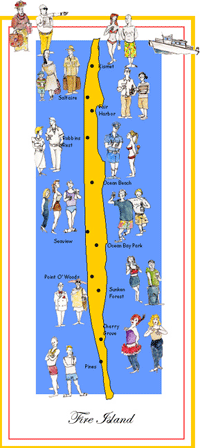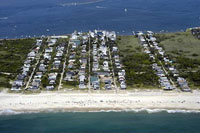 Discussion of Meeting
Format
Discussion of Meeting
Format
Managing Our Deer
by Bradlee White
The Fire Island National Seashore (FINS) has a problem; therefore,
we, the people who visit and live in the communities do too. Although the
communities are semi-independent entities, we are all part of the United States
National Parks system (NPS) – just like Yellowstone. We got here of our
own volition (long story – ask an old-timer). This isn’t the first time
we’ve faced the law of unintended consequences.
FINS was tasked by National Park Service to create a Deer
Management Program. They have been working on it for two years, including
some “public” scoping and now they have announced it. They will accept
public comments via letter or email through OCTOBER 10. They were
required to hold two public meetings. They were not, apparently, required
to make them easily accessible especially with the very short notice we
received via the Fire Island Association and its community leader
members. Kismet homeowners got fast notice and we passed the word
on. A night meeting with no ferry return was not an option. There
was a very concerned turnout at the Ocean Beach School on Friday afternoon, the
22nd.
Frankly, the National Park Service, FINS, the Feds, do not
particularly want residents here. We are an anomaly. They have
other mandates and responsibilities: Nature and its preservation as
dictated by their bosses and by statute. This can’t be easy. People
visit Yellowstone – they do not live there and they do not question or vocally
oppose the Park’s administration. Nevertheless, we the people of Fire
Island, do live here and have questions and concerns.
FINS planned the meeting as an “Open House” where people could
move from table to table reading their extensive signage and asking questions
of the rangers assigned to the tables. The people in attendance asked and
voted for an open meeting instead so that everyone could hear the information
at the same time as well as hear their neighbor’s questions and comments.

Superintendent
Soller speaking to participant
While first refusing to change the meeting format,
Superintendent Soller reluctantly agreed to “ten minutes” which stretched until
the meeting ended at four.
FINS tells us there are too many deer here: the native
plants are suffering because the deer have been grazing on them.
Therefore, depending upon which of the four options they have presented in
their Deer Management Program, they may carry out a program of “translocation”
of deer that approach people (criteria to be established) and/or “euthanasia”
to reduce the overpopulation in addition to fencing and public
education.

Looking
at FINS charts
Many Fire Islanders question the assumptions behind the
plan. For instance, the Plan cites an actual reduction in the deer
population from 257 per square mile in the mid-nineties to 106 in 2012.
It barely notes the role that years of Immunocontraception efforts beginning in
1992 played. It was suggested that since scientists are developing a
longer lasting version of the vaccine, Immunocontraception might be extended
again on a “research basis”. Park Staff answered that NPS will not
approve more research with the same vaccine and that, based on FDA findings,
New York State will not approve a vaccine unless the FDA clears it for “huntable”
populations. They anticipate that an approvable vaccine is ten years
away. In the meantime, the plan abounds with words like “euthanasia,”
“public hunting” and “sharp shooters” for population reduction.
The last count in 2012 also does not account for the loss of deer
because of Sandy. It speaks of nuisance deer roaming the communities,
begging for handouts or eating overturned garbage, even posing potential danger
to people as well as to plants. The people attending the meeting agreed
that there has been a dramatic decrease in deer sightings and that a lot, if
not most of the homeowners, have built “corrals” which do not allow garbage
flipping by either deer or raccoons.

Donna
and Rich of Fire Island Wildlife Foundation
People at the meeting brought up damage to plants from the salt
spray of the storms and the fact the "native" may be hard to define
given that people bring in and plant all sorts of things, including bamboo, the
most invasive plant of all. Extensive use of pesticides must also be a
factor. Other suggestions included surgical sterilization of male deer (not so
far-fetched according to a Veterinarian present) and the importation of wolves.

FINS
biologist Lindsay Ries
When questioned about the “euthanasia”, Park staff were at first
defensive. It was pointed out that in 1988, the family that deeded the
land for the Sunken Forest threatened to take the land back if hunting was
allowed. A Park staff person at first denied this, maintaining that
“getting a permit” would allow shooting anywhere. Later Superintendent Soller
stated there would be no hunting in the Sunken Forest or in the communities
(although options 3 and 4 specify that there may be “euthanasia” in the
communities.
A final thought. The cost per deer (60) killed by hunters in
1988’s public hunt was $1000 per deer. It is also extremely expensive to
anesthetize and move a deer.

Listening
intently
FINS
was tasked by NPS to create a Deer Management Program:
Deer Management Plan
.... Working for Fire Islanders
since 1955
Fire Island National Seashore (FINS)
Draft White-tailed Deer Management Plan and Environmental Impact
Statement (EIS)
Lead Agency: National
Park Service (NPS), U.S. Department of the Interior
Cooperating Agencies: New York
State Department of Environmental Conservation (NYS-DEC)
and Animal and Plant Health Inspection Service (APHIS), U.S.
Department of Agriculture
Comment Period Ends on October 10, 2014
Scroll down to the end for directions on how to comment
Brief Summary of EIS
**See the full text of the Draft EIS at http://parkplanning.nps.gov/document.cfm?documentID=60638.
Purpose of the Plan/EIS:
1. Develop a deer management strategy that supports
protection, preservation, regeneration, and restoration of native vegetation
and other natural and cultural resources at the Seashore and reduces
undesirable human-deer interactions in the Fire Island communities.
2. Promote public understanding of the complex
relationship between deer and Seashore resources, tick-borne diseases, people,
and human infrastructure.
3. Address impactsassociated with changes in
white-tailed deer abundance, distribution, and behavior across the Seashore,
e.g. o
Heavy browsing by white-tailed deer has resulted
in adverse impacts on native vegetation
o Abundant food sources and shelter in the
Fire Island communities have resulted in adverse interactions between deer and humans
and the developed environment.
o Adverse interactions also occur due to the habituation
of deer to the unthreatening presence of humans and conditioning of deer,
particularly to food sources, in the Fire Island communities and high-visitor
use areas.
2
The Four Management
Alternatives: The Draft White-tailed Deer Management Plan and Environmental
Impact Statement describes four alternatives for the management of
white-tailed deer at Fire Island National Seashore
Alternative A(the ‘no-action’ alternative) would
continue to implement current management actions,policies, and monitoring
efforts related to deer and their impacts. Current actions within the
Seashore include limited public education and interpretation
efforts, vegetation monitoring, and
deer population and behavior surveys.
Strategies Common to All Action Alternatives:
All three ‘action’ alternatives below (B, C, and D) would include
the following common strategies:
s enhanced public education and outreach effort,
s fencing of the maritime holly forest within the Sunken Forest,
s securing the boundary fence at the William Floyd Estate,
s small-scale fencing to protect special-status species,
s increased vegetation monitoring,
s enhanced deer population and behavior monitoring, and close
coordination with the New York State Department of Environmental Conservation.
Additional actions specific to Alternatives B, C and D would
include the following:
Alternative B: additional deer browsing management
actions would include:
• fencing of the historic core at the William Floyd Estate and
rotational fencing of selected forest areas at the William Floyd Estate lower
acreage.
• The fencing would be implemented in conjunction with fertility
control of white-tailed deer to gradually reduce and then maintain the deer
population at an appropriate density to achieve the plan objectives.
• Deer observed approaching humans within the Fire Island
communities would be relocated to the Fire Island Wilderness.
Alternative C (the environmentally preferable
alternative), additional actions would include:
• to directly reduce and maintain the deer population at an
appropriate deer densityto allow for vegetation regeneration.
• Deer population reduction and maintenance would be implemented
through a combination of sharpshooting, capture and euthanasia of individual
deer (where necessary), and public hunting (within the Fire Island Wilderness
only).
• Deer observed approaching humans within the Fire Island
communities would be captured and euthanized to reduce the risk of negative
human-deer interactions and prevent other deer from learning this behavior
through observation.
3
Alternative D(the NPS
preferred alternative) would include a combination of actions from both alternatives
B and C:
• The historic core at the William Floyd Estate would be fenced to
exclude deer.
• The deer population on Fire Island and at the William Floyd
Estate lower acreage would be reduced to an appropriate deer density to achieve
the plan objectives through a combination of sharpshooting, capture and
euthanasia of individual deer (where appropriate), and public hunting (within
the Fire Island Wilderness only).
• Once reduced, the deer population could be maintained through
fertility control or a continuation of actions used for direct reduction.
• Similar to alternative C, deer observed approaching humans
within the Fire Island communities would be captured and euthanized.
Reviewers and Respondents Please Note:
If you wish to comment on this plan/EIS, you may
1. Post them electronically at
http://parkplanning.nps.gov/FireIslandDeerManagementPlan or
2. Mail comments to the name and address below.
Before including your address, phone number, email address, or
other personal identifying information in your comment, you should be aware
that your entire comment, including your personal identifying information, may
be made publicly available at any time.
While you can ask FINS in your comment to withhold your personal
identifying information from public review, they cannot guarantee that they
would be able to do so.
Next steps:
1. After public review is completed, this plan/EIS will be revised
in response to public comments.
2. A final version of this plan/EIS will then be released, and a
30-day no-action period will follow.
3. After the 30-day no-action period, the alternative or actions
constituting the approved plan will be documented in a record of decision that
will be signed by the Regional Director of the Northeast Region.
For further information regarding this plan/EIS, please contact:
Lindsay Ries, Wildlife Biologist
Fire Island National Seashore
120 Laurel Street
Patchogue, NY 11772
Lindsay_Ries@nps.gov
See full text and summaries at http://parkplanning.nps.gov/document.cfm?documentID=60638.
Post your comments at http://parkplanning.nps.gov/FireIslandDeerManagementPlan or
2. If you don't receive a receipt confirmation from the internet sysetm or have questions, contact:
Lindsay_Ries@nps.gov
Mail comments to the name and address below.
Superintendent, Fire Island National Seashore, 120 Laurel St., Patchogue, NY 11772
Attn: Draft White Tail Deer Management Plan
Before including your address, phone number, email address, or other personal identifying information in your comment, you should be aware that your entire comment, including your personal identifying information, may be made publicly available at any time.
While you can ask FINS in your comment to withhold your personal identifying information from public
review, they cannot guarantee that they would be able to do so.















